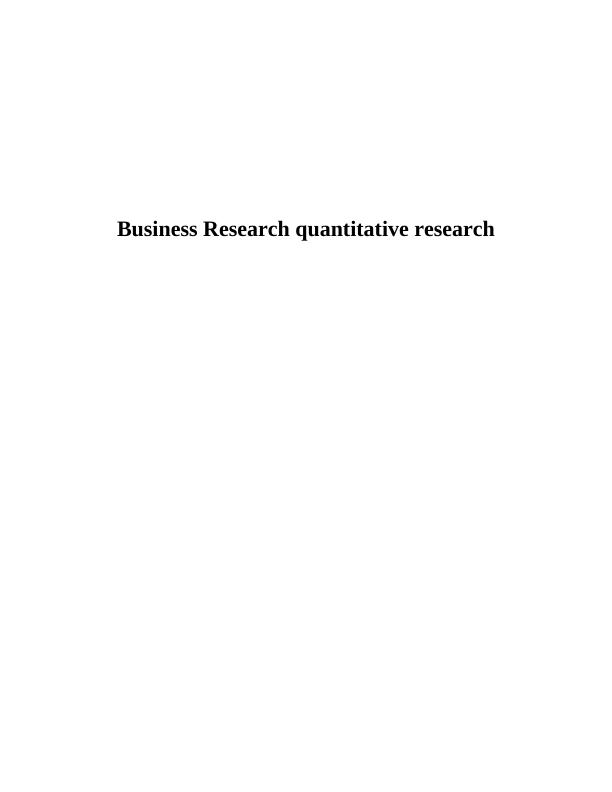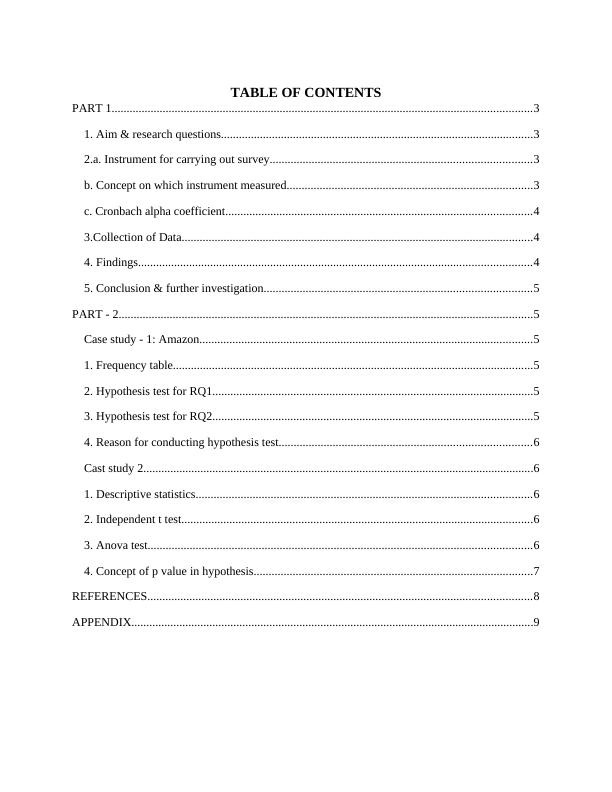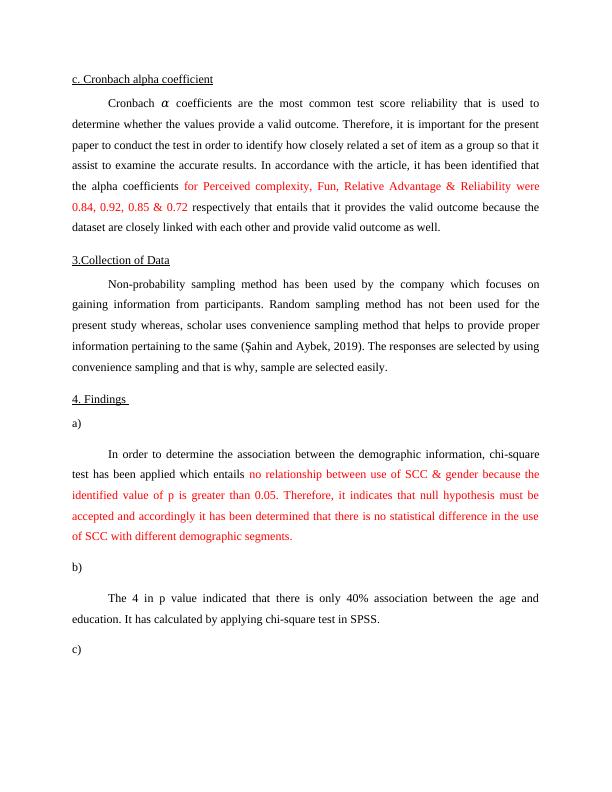Comparison of non-users and users of self-checkout counters in Singapore's retail industry
Added on 2023-06-09
12 Pages1725 Words140 Views
Business Research quantitative research

TABLE OF CONTENTS
PART 1............................................................................................................................................3
1. Aim & research questions........................................................................................................3
2.a. Instrument for carrying out survey.......................................................................................3
b. Concept on which instrument measured..................................................................................3
c. Cronbach alpha coefficient......................................................................................................4
3.Collection of Data.....................................................................................................................4
4. Findings...................................................................................................................................4
5. Conclusion & further investigation.........................................................................................5
PART - 2..........................................................................................................................................5
Case study - 1: Amazon...............................................................................................................5
1. Frequency table........................................................................................................................5
2. Hypothesis test for RQ1...........................................................................................................5
3. Hypothesis test for RQ2...........................................................................................................5
4. Reason for conducting hypothesis test....................................................................................6
Cast study 2..................................................................................................................................6
1. Descriptive statistics................................................................................................................6
2. Independent t test.....................................................................................................................6
3. Anova test................................................................................................................................6
4. Concept of p value in hypothesis.............................................................................................7
REFERENCES................................................................................................................................8
APPENDIX......................................................................................................................................9
PART 1............................................................................................................................................3
1. Aim & research questions........................................................................................................3
2.a. Instrument for carrying out survey.......................................................................................3
b. Concept on which instrument measured..................................................................................3
c. Cronbach alpha coefficient......................................................................................................4
3.Collection of Data.....................................................................................................................4
4. Findings...................................................................................................................................4
5. Conclusion & further investigation.........................................................................................5
PART - 2..........................................................................................................................................5
Case study - 1: Amazon...............................................................................................................5
1. Frequency table........................................................................................................................5
2. Hypothesis test for RQ1...........................................................................................................5
3. Hypothesis test for RQ2...........................................................................................................5
4. Reason for conducting hypothesis test....................................................................................6
Cast study 2..................................................................................................................................6
1. Descriptive statistics................................................................................................................6
2. Independent t test.....................................................................................................................6
3. Anova test................................................................................................................................6
4. Concept of p value in hypothesis.............................................................................................7
REFERENCES................................................................................................................................8
APPENDIX......................................................................................................................................9

PART 1
1. Aim & research questions
The purpose of the research is to compare how the non-users & users of self-checkout
counters differ with respect to the retail industry of Singapore.
The research questions are:
Q1: Is there any demographic difference among non-users & users of self-checkout counters or
SCC?
Q2: What perceptual differences lies among the non-users & users of SCC with regards to the
features of SCC in Singapore which involves fun, complexity, relative advantage, compatibility
and reliability?
Q3: What differences lies in terms of situational factors that are supposed to be affecting the
intention of non-users and users of SCC while using terminals?
2.a. Instrument for carrying out survey
The chosen instrument for survey consists of three section which include:
Demographic information that include age, gender and educational qualification
Five point Likert scale questions that identify the reliability in order to measure the
respondent’s point of view related to SCC.
Seven point likert scale questions that help to determine the probability of using SCC in
different situation.
b. Concept on which instrument measured
The name of the second section is 5 point Likert scale questionnaire that help would be
helpful in determining the perception of SCC. In this different dimension used which include
perceived complexity, fun, relative advantage & reliability measured that will further measure by
three item scale adapted. Next, compatibility of SCC which a respondent’s lifestyle by using the
framework given by Roger. Therefore, it can be stated that there are different factors which need
to be used in order to provide valid outcome.
1. Aim & research questions
The purpose of the research is to compare how the non-users & users of self-checkout
counters differ with respect to the retail industry of Singapore.
The research questions are:
Q1: Is there any demographic difference among non-users & users of self-checkout counters or
SCC?
Q2: What perceptual differences lies among the non-users & users of SCC with regards to the
features of SCC in Singapore which involves fun, complexity, relative advantage, compatibility
and reliability?
Q3: What differences lies in terms of situational factors that are supposed to be affecting the
intention of non-users and users of SCC while using terminals?
2.a. Instrument for carrying out survey
The chosen instrument for survey consists of three section which include:
Demographic information that include age, gender and educational qualification
Five point Likert scale questions that identify the reliability in order to measure the
respondent’s point of view related to SCC.
Seven point likert scale questions that help to determine the probability of using SCC in
different situation.
b. Concept on which instrument measured
The name of the second section is 5 point Likert scale questionnaire that help would be
helpful in determining the perception of SCC. In this different dimension used which include
perceived complexity, fun, relative advantage & reliability measured that will further measure by
three item scale adapted. Next, compatibility of SCC which a respondent’s lifestyle by using the
framework given by Roger. Therefore, it can be stated that there are different factors which need
to be used in order to provide valid outcome.

c. Cronbach alpha coefficient
Cronbach 𝛼 coefficients are the most common test score reliability that is used to
determine whether the values provide a valid outcome. Therefore, it is important for the present
paper to conduct the test in order to identify how closely related a set of item as a group so that it
assist to examine the accurate results. In accordance with the article, it has been identified that
the alpha coefficients for Perceived complexity, Fun, Relative Advantage & Reliability were
0.84, 0.92, 0.85 & 0.72 respectively that entails that it provides the valid outcome because the
dataset are closely linked with each other and provide valid outcome as well.
3.Collection of Data
Non-probability sampling method has been used by the company which focuses on
gaining information from participants. Random sampling method has not been used for the
present study whereas, scholar uses convenience sampling method that helps to provide proper
information pertaining to the same (Şahin and Aybek, 2019). The responses are selected by using
convenience sampling and that is why, sample are selected easily.
4. Findings
a)
In order to determine the association between the demographic information, chi-square
test has been applied which entails no relationship between use of SCC & gender because the
identified value of p is greater than 0.05. Therefore, it indicates that null hypothesis must be
accepted and accordingly it has been determined that there is no statistical difference in the use
of SCC with different demographic segments.
b)
The 4 in p value indicated that there is only 40% association between the age and
education. It has calculated by applying chi-square test in SPSS.
c)
Cronbach 𝛼 coefficients are the most common test score reliability that is used to
determine whether the values provide a valid outcome. Therefore, it is important for the present
paper to conduct the test in order to identify how closely related a set of item as a group so that it
assist to examine the accurate results. In accordance with the article, it has been identified that
the alpha coefficients for Perceived complexity, Fun, Relative Advantage & Reliability were
0.84, 0.92, 0.85 & 0.72 respectively that entails that it provides the valid outcome because the
dataset are closely linked with each other and provide valid outcome as well.
3.Collection of Data
Non-probability sampling method has been used by the company which focuses on
gaining information from participants. Random sampling method has not been used for the
present study whereas, scholar uses convenience sampling method that helps to provide proper
information pertaining to the same (Şahin and Aybek, 2019). The responses are selected by using
convenience sampling and that is why, sample are selected easily.
4. Findings
a)
In order to determine the association between the demographic information, chi-square
test has been applied which entails no relationship between use of SCC & gender because the
identified value of p is greater than 0.05. Therefore, it indicates that null hypothesis must be
accepted and accordingly it has been determined that there is no statistical difference in the use
of SCC with different demographic segments.
b)
The 4 in p value indicated that there is only 40% association between the age and
education. It has calculated by applying chi-square test in SPSS.
c)

End of preview
Want to access all the pages? Upload your documents or become a member.
Related Documents
Business Research Methods: Survey Instrument, Sampling Method, and Hypothesis Testinglg...
|13
|2008
|60
Business Research Methods - Deskliblg...
|12
|2175
|98
Business Research Methods Study on Users and Non-Users of Self-Checkout Counterslg...
|18
|2539
|139
Examining Users and Non-Users of Self-Checkout Counters in Singaporelg...
|12
|1632
|461
Analysis of Self-Checkout Counters in Retail Industry and Entrepreneurship Intentionlg...
|19
|2710
|336
Analysis of Self-Checkout Counters in Retail Industrylg...
|20
|2695
|313